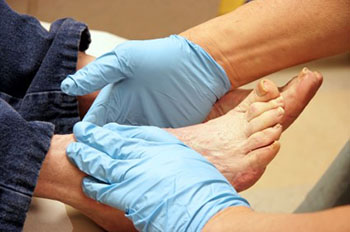
DIABETES COMPLICATIONS
WHAT IS IT?

People living with diabetes are prone to having foot problems, often because of two complications of diabetes: nerve damage (neuropathy) and poor circulation. Neuropathy causes loss of feeling in your feet, taking away your ability to feel pain and discomfort, so you may not detect an injury or irritation. Poor circulation in your feet reduces your ability to heal, making it hard for even a tiny cut to resist infection.
Having diabetes increases the risk of developing a wide range of foot problems. Furthermore, with diabetes, small foot problems can turn into serious complications.

SYMPTOMS
As "overuse" disorders, Achilles tendinitis and tendonosis are usually caused by a sudden increase of a repetitive activity involving the Achilles tendon. Such activity puts too much stress on the tendon too quickly, leading to micro-injury of the tendon fibers. Due to this ongoing stress on the tendon, the body is unable to repair the injured tissue. The structure of the tendon is then altered, resulting in continued pain.
Athletes are at high risk for developing disorders of the Achilles tendon. Achilles tendinitis and tendonosis are also common in individuals whose work puts stress on their ankles and feet, such as laborers, as well as in “weekend warriors”—those who are less conditioned and participate in athletics only on weekends or infrequently.
In addition, people with excessive pronation (flattening of the arch) have a tendency to develop Achilles tendinitis and tendonosis due to the greater demands placed on the tendon when walking. If these individuals wear shoes without adequate stability, their overpronation could further aggravate the Achilles tendon.

SYMPTOMS
Infections and ulcers (sores) that do not heal. An ulcer is a sore in the skin that may go all the way to the bone. Because of poor circulation and neuropathy in the feet, cuts or blisters can easily turn into ulcers that become infected and will not heal. This is a common—and serious—complication of diabetes and can lead to a loss of your foot, your leg or your life.
Corns and calluses. When neuropathy is present, you cannot tell if your shoes are causing pressure and producing corns or calluses. Corns and calluses must be properly treated or they can develop into ulcers.
Dry, cracked skin. Poor circulation and neuropathy can make your skin dry. This may seem harmless, but dry skin can result in cracks that may become sores and can lead to infection.
Nail disorders. Ingrown toenails (which curve into the skin on the sides of the nail) and fungal infections can go unnoticed because of loss of feeling. If they are not properly treated, they can lead to infection.
Hammertoes and bunions. Nerve damage aecting muscles can cause muscle weakness and loss of tone in the feet, resulting in hammertoes and bunions. If le untreated, these deformities can cause ulcers.
Charcot foot. This is a complex foot deformity. It develops as a result of loss of sensation and an undetected broken bone that leads to destruction of the so tissue of the foot. Because of neuropathy, the pain of the fracture goes unnoticed and the patient continues to walk on the broken bone, making it worse. This disabling complication is so severe that surgery, and occasionally amputation, may become necessary.
Poor blood flow. In diabetes, the blood vessels below the knee oen become narrow and restrict blood flow. This prevents wounds from healing and may cause tissue death.

TREATMENT
Your foot and ankle surgeon can help wounds heal, preventing amputation. Many new surgical techniques are available to save feet and legs, including joint reconstruction and wound healing technologies. Getting regular foot checkups and seeking immediate help when you notice something can keep small problems from worsening. Your foot and ankle surgeon works together with other healthcare providers to prevent and treat complications from diabetes.

WHY CHOOSE A FOOT AND ANKLE SURGEON?
Foot and ankle surgeons are the leading experts in foot and ankle care today. As doctors of podiatric medicine – also known as podiatrists, DPMs or occasionally “foot and ankle doctors” – they are the board-certified surgical specialists of the podiatric profession. Foot and ankle surgeons have more education and training specific to the foot and ankle than any other healthcare provider.
Foot and ankle surgeons treat all conditions affecting the foot and ankle, from the simple to the complex, in patients of all ages including Haglund's deformity. Their intensive education and training qualify foot and ankle surgeons to perform a wide range of surgeries, including any surgery that may be indicated for Haglund's deformity.

